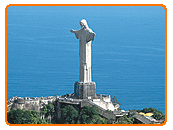 Christ the Redeemer is a statue of Jesus Christ in Rio de Janeiro, Brazil. The statue stands 38 m (105 feet) tall, weighs 700 tons and is located at the peak of the 700-m (2296-foot) Corcovado mountain in the Tijuca Forest National Park, overlooking the city. Being a symbol of the Roman Catholic Church, the statue has also become an icon of Rio and Brazil. Christ the Redeemer is a statue of Jesus Christ in Rio de Janeiro, Brazil. The statue stands 38 m (105 feet) tall, weighs 700 tons and is located at the peak of the 700-m (2296-foot) Corcovado mountain in the Tijuca Forest National Park, overlooking the city. Being a symbol of the Roman Catholic Church, the statue has also become an icon of Rio and Brazil.
The monument that is synonymous with the city of Rio de Janeiro is vying to be chosen one of the New Seven Wonders of the World.
The idea for erecting a large statue atop Corcovado had been around since the mid 1850s, when Catholic priest Pedro Maria Boss requested financing from Princess Isabel to build a large religious monument.[citation needed] Princess Isabel did not think much of the idea, which was completely dismissed in 1889, when Brazil became a Republic, with laws mandating the separation of church and state.[citation needed]
Looming 100-feet high, arms outstretched, the Christ the Redeemer statue is competing with the Taj Mahal, the Eiffel Tower, and Machu Picchu in the international contest.
Christ the Redeemer with Corcovado in background.The second proposal for a large landmark statue on the mountain was made in 1921 by the Archdiocese of Rio de Janeiro.[citation needed] The archdiocese organized an event called Semana do Monumento ("Monument Week") to attract donations. The donations came mostly from Brazilian Catholics.[1] The designs considered for the "Statue of the Christ" included a representation of the Christian cross, a statue of Jesus with a globe in his hands, and a pedestal symbolizing the world. [citation needed] The statue of Christ the Redeemer with open arms was chosen.
|







